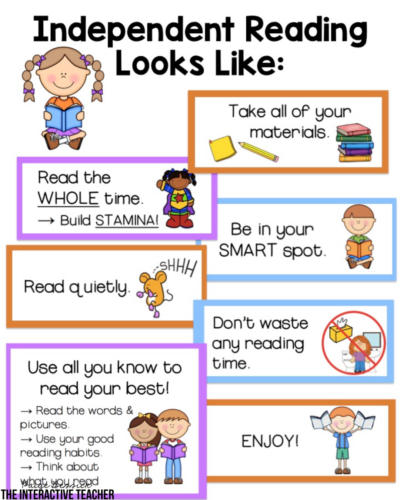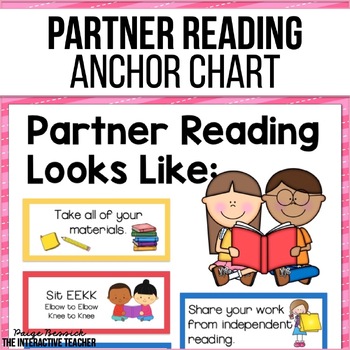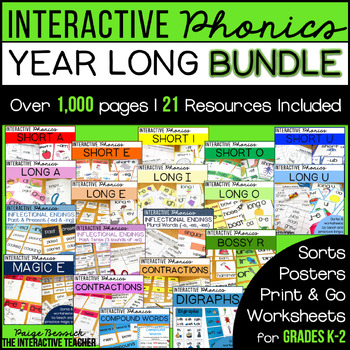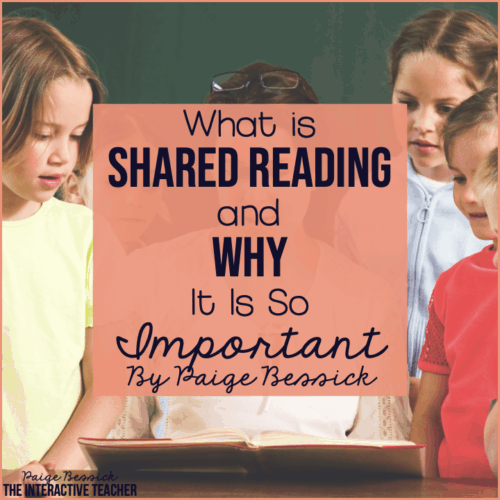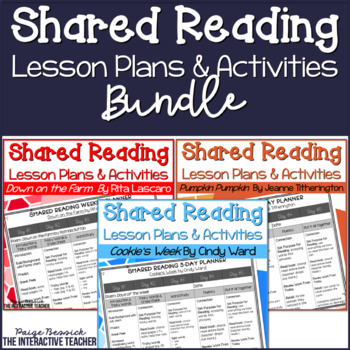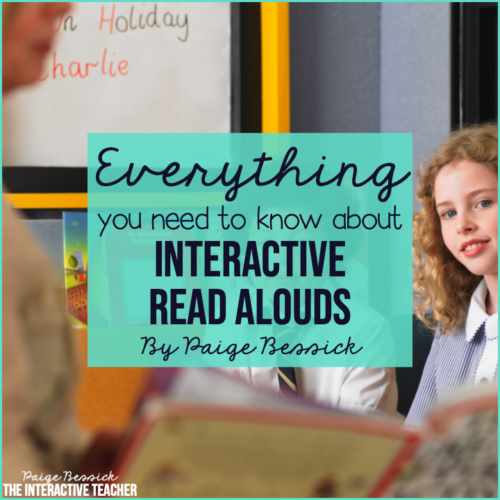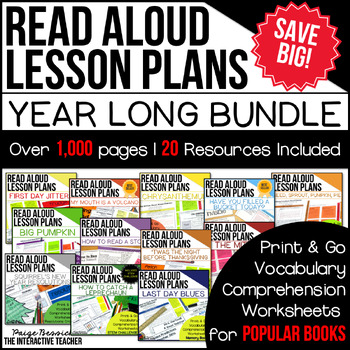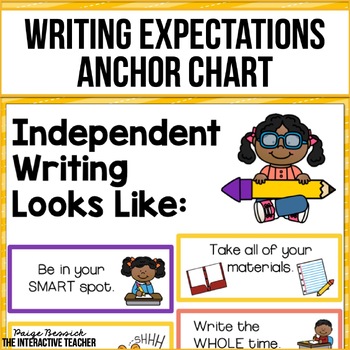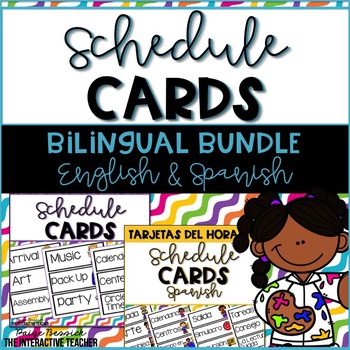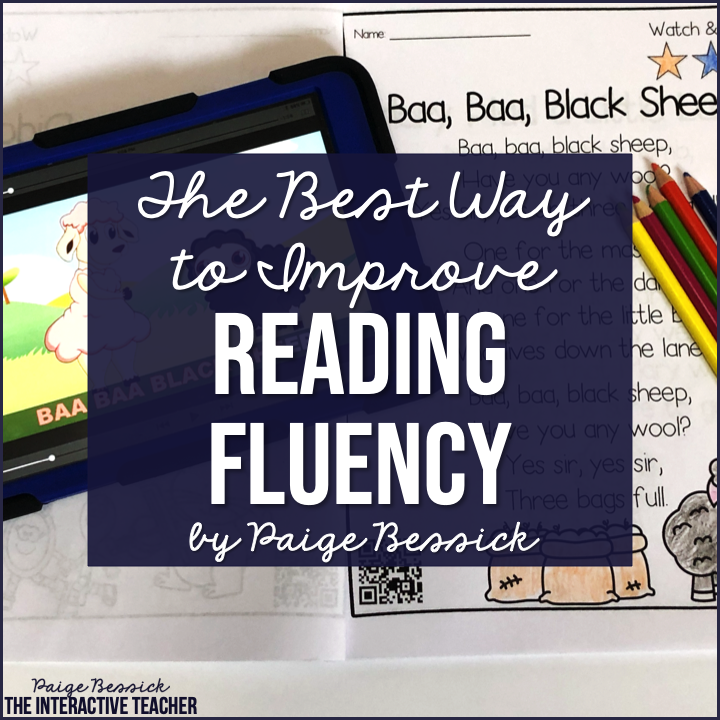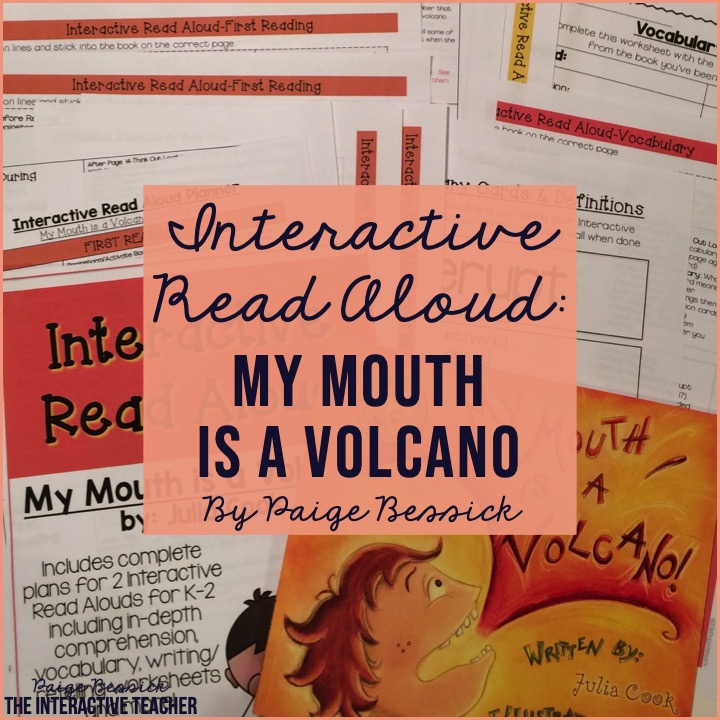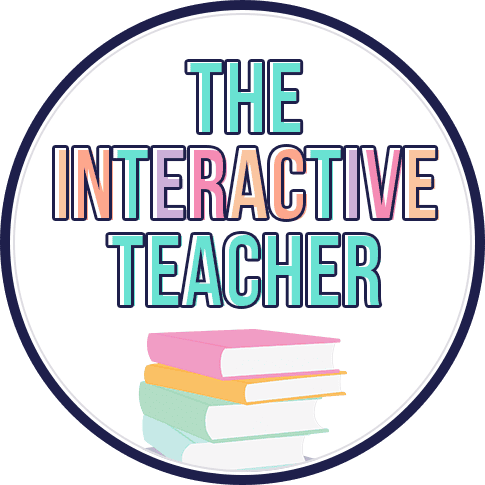One of the most asked questions I get as I present at workshops is, “How do you fit it all in?” Most of my presentations or workshops focus on interactive read alouds and shared reading, things that are often “left out” of a daily schedule. While I’m presenting, I’m usually reiterating the importance of making room for these in your schedule and participants always want to know how I fit it all in. Well today, folks, I’m here to show you how it can be done and how not to “leave out” those vital components of balanced literacy. Keep reading to see what my first grade schedule looks like and how I fit it all in.
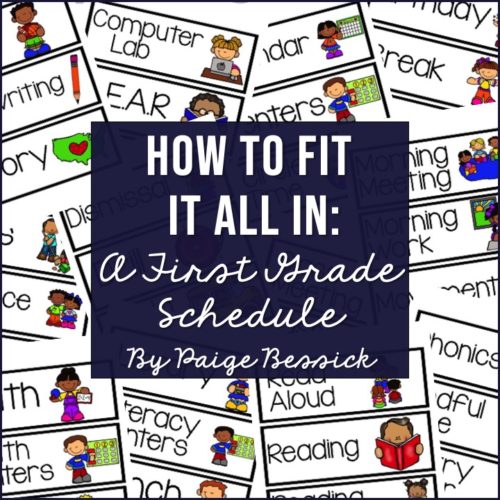
This post contains affiliate links to Amazon. By purchasing an item on the Amazon site using these links, I will receive a small commission on your purchase. This helps me continue writing this blog and providing you with teaching tips and ideas. Thank you!
*Side note: as the pendulum shifts again, in 2023, (hello Science of Reading), if you are still using a reading workshop model, this is perfect for you! I’ve tried to update as much as I can, but also know that people have many different beliefs and ideas of what a literacy schedule should look like.
I have to say that I’m pretty lucky in the fact that our principal makes our basic schedule. Because of our reading support teachers, Title 1 teachers, specials teachers who rotate between schools, and students who switch for math in the upper grades, our principal has taken it upon herself to give us the bare-bones schedule that we need to follow. This is quite the feat every year, but it’s really nice to not have to worry about creating my own.
I want to preface this blog post by letting you know that this was my typical schedule for an English Language Immersion, general ed classroom. This is what I used for almost 10 years before I started teaching in our Two-Way Immersion, Spanish program.
First Grade Schedule
We get 70 minutes for our math block and 100 minutes for our literacy block. It just so happens that lunch splits our literacy block into 2 sections, but it actually works out quite well.
Here’s my daily schedule:
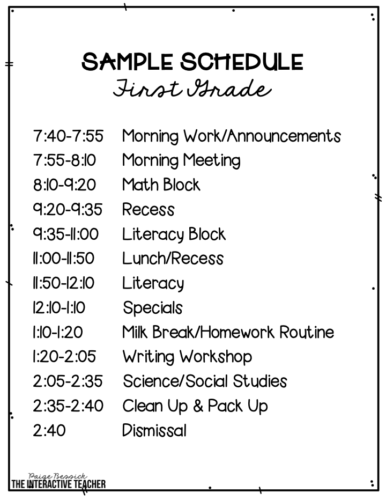
We actually run on a 6-day schedule that allows for us to have an hour of specials/PLC time each day. We are able to have shared team time and meet with our PLC once a week.
First Grade Specials Schedule
Here is our specials schedule:

A First Grade Schedule: Fitting It All In
Now to the big question: How do I fit it all in? Now that you know what our daily schedule looks like, the big question still remains. I will say right from the beginning, that I am no expert at fitting it all in. There are days when something takes longer than expected, or we have to skip something. I’m your typical teacher. But I’m also that type A teacher who is organized and has a schedule that I follow to a ‘T’ as much as I can. If it’s scheduled in, I’m more likely to do it.
Math
Let’s start with math, it’s a little bit easier to schedule in all of the components.
Here’s our daily math schedule:
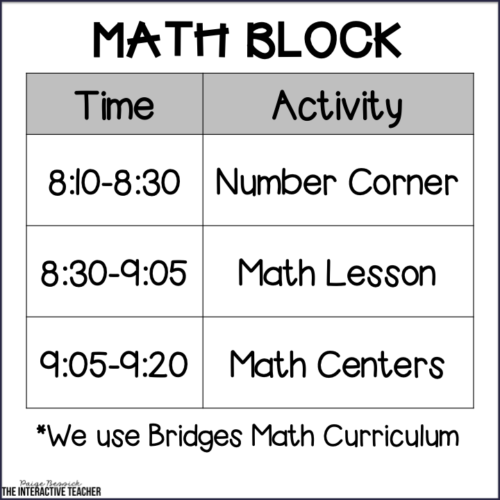
We use the Bridges Math Curriculum. This is our second year using it and I’m still learning how to best implement, but this is our basic daily schedule.
If you’re looking for more time examples, this schedule below is for you.
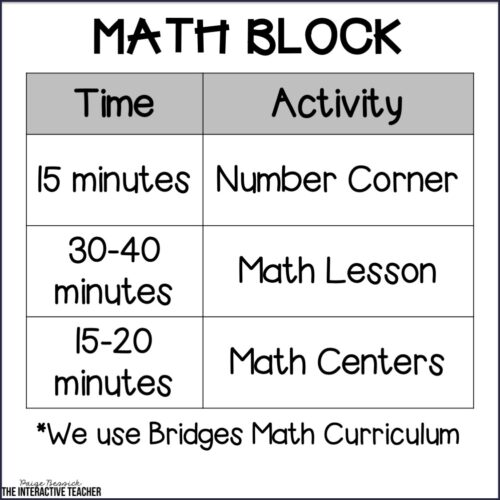
Number Corner: Number corner is essentially a calendar routine. It includes calendar cards, number of the day, a collection routine, computational fluency and number line activities. It’s very engaging and the activities go fast so it keeps the students engaged and learning. It is also a great place for students to take the lead and be in charge of several activities. As the teacher’s helper, a student can practically run about 75% of the day’s activities.
Math Lesson: Bridges is the daily lesson. It follows 8 units that teach necessary math standards and practices. It takes about 30 minutes to teach. It includes hands-on activities as well as direct instruction and student journals.
Math Centers: The last component of our math block is Bridges Work Places. These are essentially math centers. The students rotate daily between the centers playing math games. This is when I have a Title 1 teacher in to support and we pull small groups for additional teaching. As we’re pulling groups, the rest of the students are at a center playing a math game with their partner or small group. Teaching expectations and how to play the games is key to getting these to run smoothly, but the students love them.
Literacy
Let’s move on to literacy. This one is a little more tricky to schedule and fit everything in a daily first grade schedule.
Here is our daily literacy schedule:
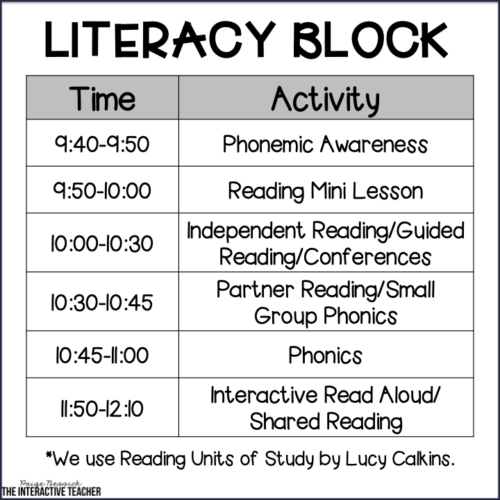
Here is another option that shows more phonics instruction and how much time can be spent on each activity. If you don’t do a units of study or workshop model, take out the reading mini lesson.
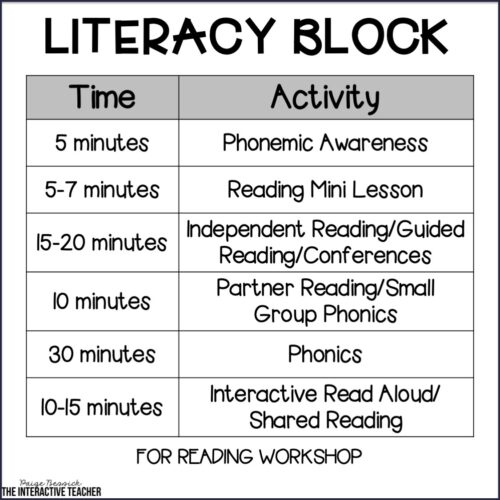
Now let’s talk about each component of our literacy block.
Phonemic Awareness
In a first grade schedule, phonemic awareness is a must! PA is so important because it is the base of learning how to read. Students need to be able to rhyme, blend, segment, and manipulate sounds and letters auditorily before moving on to using letters and words.
I’m not going to go into more now, but if you’re interested in learning more, check out >>THIS<< blog post: PHONEMIC AWARENESS VS. PHONOLOGICAL AWARENESS AND HOW TO SUPPORT OUR YOUNGEST READERS
I’ve been using the Michael Heggerty Phonemic Awareness book for most of my teaching career, over 15 years. It makes it fun and easy to implement and only takes about 10 minutes a day. Check it out >>HERE<< or by clicking on the image below.
Reading Mini-Lesson
If you use Reading Units of Study by Lucy Calkins, you will have this in your schedule. As a reading workshop model, I would teach a minilesson that is no longer than 7 minutes, that teaches a specific skill I want my students to learn and work on during their reading that day. My minilessons contain the 4 main components: connecting, teaching point/teaching, active engagement, and the link. I keep it mini and then send my students off to read.
Independent Reading/Guided Reading/Conferences
This is the bulk of my reading block in my first grade schedule. My students get about 20-30 minutes (by the end of the year-we work up to this) to independently read and practice the skill I taught during my minilesson. With reader’s workshop, the whole idea is that students practice reading books at their independent reading level. If you want to get better at something, you have to practice, so this time is vital in my students learning.
While they are independently reading, I am meeting with guided reading groups with my students who are just at or below grade level and conferring with individuals or small groups for those students above grade level. I’m very lucky that at this time I have a reading specialist in my classroom to help support my students. Between the 2 of us, we meet with 4 guided reading groups a day. If I’m not working with a guided reading group, I’m conferring with students based on specific skills they need to work on: fluency, comprehension, retelling, word solving, etc.
Teaching Litearcy Expecatations
I’m going to go off topic a little bit, but feel that I must mention it. So much of what happens in our classroom is based on the expectations that are taught. What I mean, is that all of the activities that we do, have specific expectations.
Teaching my students these expectations is so important. To teach these literacy expectations, I create anchor charts with my students that have the expectations.
I have a lot of different anchor chart options. Check out >>THIS<< TPT category in my store: Anchor Charts. I have both English and Spanish options for most of them.
I use >>THIS<< book to help with my small group/individual conferences. Click >>HERE<< or on the book image below.
Partner Reading/Small Group Phonics
Moving onto our next activity, depending on the day and what’s going on, my students are either partner reading or getting small group phonics instruction. At this time, I still have the reading specialist and our ELL teacher also comes into my room at that time. Based on some phonemic awareness and/or phonics assessments, we have decided to meet with small groups to focus on specific PA or phonics skills that are holding my students back (blending, segmenting, letter names/sounds, etc.).
While they are working with my most struggling learners, I have the rest of my group. At this time I have done several things. We will often continue partner reading because I know the importance of it (and the kids love it). I will sometimes introduce a trickier phonics skill (like long vowels, contractions, inflectional endings) for these students because they are ready for them. I have also done book clubs at this time too. Depending on what I think my students need, I pick and choose between those activities.
>>HERE<< is a partner reading anchor chart that I use to teach expectations.
Phonics/Word Work
The last thing we do before lunch is word work. Phonics or word work may be just the most important thing you do. ina first grade schdeule. At this time, I’m teaching phonics to my entire class. I use my Interactive Phonics resources all year. At this time, I can differentiate for all of my learners based on the words we use and practice with.
For example, if we’re doing short a, some students will be getting the basic CVC short /a/ words (cat, hat, van, map, etc.). Other students get trickier short a words that include blends and digraphs (than, math, champ, etc.).
I believe that phonics (and phonemic awareness) is one of the most important skills I teach in first grade. I feel with phonics instruction, it is so important for students to be taught using the gradual release of responsibility, an I do, we do, you do format. Because of this, my phonics resources include activities for just that: whole group, small group, and independent activities.
Click >>HERE<< or on the image below to see this Phonics Bundle. It includes 20 complete phonics resources for all of the short and long vowels, bossy r, contractions, inflectional endings, and compound words-everything you need for a year of phonics instruction.
In 2023, the pendulum of education swung again and the Science of Reading has come forward with saying that phonics instruction needs to be explicitly taught. While I have *ALWAYS* had it in my schedule, I have more recently started spending more time on it by giving it a full 30 minutes.
Interactive Read Aloud/Shared Reading
I have this extra literacy time between lunch and specials every day that is 20 minutes (often less when we have snow pants, #amIright?). Anyway, I rotate between interactive read alouds and shared reading.
At the beginning of the year, I tend to do more shared reading as most of my class is closer in skill level at this time. Because we are reading/writing for shorter amounts of time and haven’t built up our stamina yet at the beginning of the year, I fit in interactive read alouds at a different time. Shared reading is so important for our emergent readers so I make sure to fit this in.
Want to learn more about shared reading? Check out my blog post >>HERE<<!
You can also check out my shared reading resources by clicking >>HERE<< or by clicking on the image below.
Later on in the year, I switch to Interactive Read Alouds at that time. I still do shared reading with my striving learners during guided reading, I can share more about that later. For interactive read alouds, my students sit next to their literacy partner and we do a read aloud while constantly interacting with the book. You can learn more about IRAs from >>THIS<< blog post: Everything You Need to Know About Interactive Read Alouds.
You can check out my Interactive Read Aloud Resources >>HERE<< or my bundle by clicking the image below.
Writing
The last thing I want to mention about this first grade schedule is the writing block. We have about 45 minutes for our writing workshop. We have used Writing Units of Study by Lucy Calkins for this. My students absolutely love writing workshop. The first 10 minutes is my minilesson and the rest of the time is for independent writing time while I do small groups and individual conferencing.
At the beginning of the year, when my students are working on their writing stamina, I do some handwriting teaching/practice at the very end of writing time.
Check out my friend Sara, The Primary Pal’s, Handwriting resources. These are what I use.
And of course, I have anchor charts that I use to teach the expectations for our writing block.
Visual Schedule
So there you have it, how I fit it all in. As I said earlier, my schedule is not perfect and I’m no expert, but this works for me and my classroom. These are the components that are important to me so I work hard to fit them in every day.
One thing I believe though, is students do better when they know what to expect and what’s happening during the day. To help and support all of my learners in my classroom I have a daily schedule. Each day I change it to match what’s going to happen.
Click >>HERE<< on the image below to see these schedule cards in English and Spanish.
I hope you found this helpful. I know I always like seeing other’s schedules to see how they fit it all in. If you have any questions, or have a sample first grade schedule to share, please email me at [email protected] or comment below, I’d love to chat.
As always, please pin and share for others to see.
Disclaimer
Since originally writing this post in 2018, I have done a lot of learning and relearning regarding the best kind of instruction for first graders. While I used and loved Units of Study for Reading, Writing, and Phonics, there has been a lot of research recently about the Science of Reading and the importance of phonics instruction. Whatever program you use, make sure you are meeting the needs of your students and using best practices.



